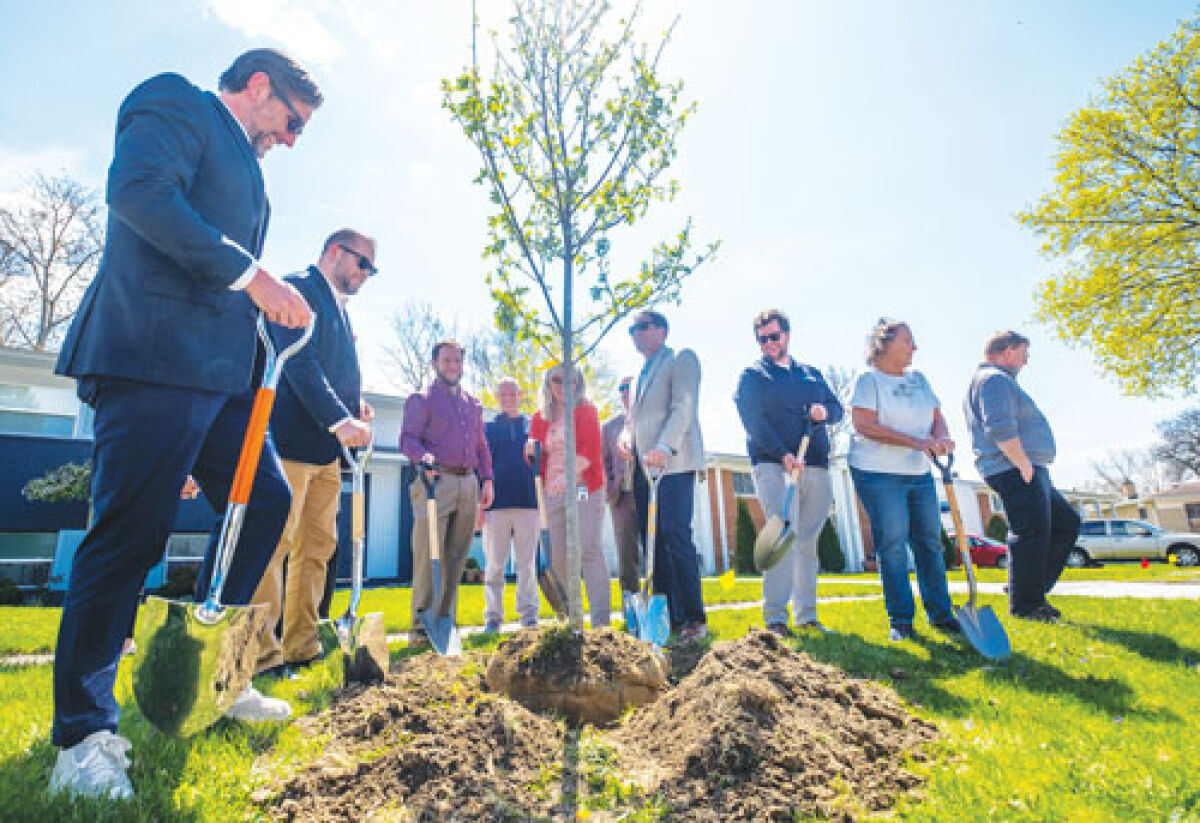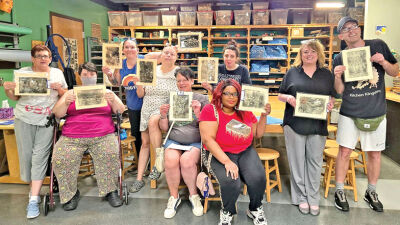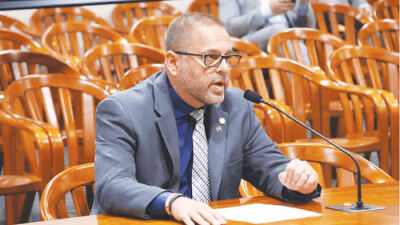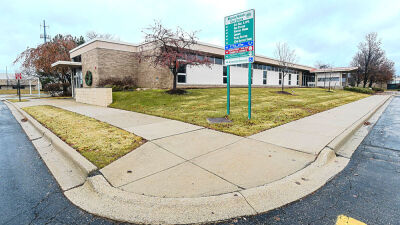
A historic chinquapin oak starts to bloom in Sterling Heights. A group of residents is trying to save the ancient tree from being cut down to make way for apartments.
Photo by Mark Graf
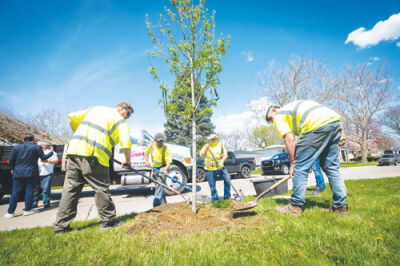
City workers rake the soil around a freshly planted tree at the April 23 event.
Photo by Brian Wells
STERLING HEIGHTS — Officials in Sterling Heights recently celebrated the planting of 200 new trees, the first of 15,000 that will be planted during the next several years, as funded by last fall’s “Pathway to Play and Preservation” millage.
Meanwhile, a group of residents stand united around saving a centuries-old chinquapin oak that is slated for destruction so new apartments can be built. The tree is among the largest of its kind in Michigan and possibly older than the United States, according to state certifiers.
The residents have formed a website, sterling-oak.org, where a petition to save the tree can be found. At press time, the petition had roughly 2,300 signatures. The group and its allies support new plantings but want more done to preserve the existing canopy.
“The city of Sterling Heights is putting in all these tiny trees, and here’s this large, beautiful tree that’s been here for ages — it’s just not the same replacing it,” said resident Kathleen Bileti.
“I understand how sometimes new developments need to go around trees, but that’s an extra expense worth making,” she said. “They knew that tree was there before they got the property. To just cut it down now would be crazy. This is not a throwaway world.”
Evan Little is an arborist certified in Tree Risk Assessment Qualification. The TRAQ program is managed by the International Society of Arboriculture.
“I often refer to these kinds of trees as ‘landmarks’ due to their size, age and value. I would definitely consider this chinquapin to be a landmark — and a historic one, for that matter,” said Little. “We could plant 200 new trees today, but in our lifetime, we won’t see them doing what this chinquapin already does today.”
‘Meadow in the sky’
The chinquapin oak stands in a flood plain on the east side of Van Dyke Avenue, south of Canal Road and north of Riverland Drive, next to Henriksen’s Golf and down the street from Zap Zone. Estimates put its age at nearly 270 years old, based on a species-specific formula by the ISA.
The nonprofit Michigan Botanical Society certified the tree as part of its Michigan Big Tree Survey, confirming its species and measurements. The tree is 88 feet tall and 14 feet around at breast height, with a crown spread of 84.5 feet — the seventh largest of its kind in the state.
“The cool thing about mature trees is they’re like a mother to all the surrounding trees and wildlife,” Little said. “You may have heard of the mycelium network — an underground fungal network uniting all trees, where they communicate with each other with their roots and send nutrients to each other. If one tree needs a bit of nitrogen because of loss during a storm, the surrounding oaks can send nitrogen to that tree. And large mature trees like this chinquapin provide so much.”
While the tree has stood near the Clinton River since the time of the Founding Fathers, and is healthy, its final days may be at hand. The Chaldean Community Foundation is planning to build 82 apartments there, after the city approved the plan and sold the land last year.
The property where the chinquapin stands, located at 43934 Van Dyke Ave., spans about 10.5 acres. The plan is for the front 2 acres to be developed, which in its current form would require the tree’s removal. The plan also requires a cut-and-fill operation where the wetlands would be dug up, moving earth to raise the front 2 acres out of the flood plain. The 8 undeveloped acres would then be deeded back to the city.
The CCF is also working on another complex two parcels south on Van Dyke Avenue, expected to be completed in July. The CCF purchased 10 acres there, built 135 apartment units on 3 acres, and donated the other 7 acres back to the city to expand the greenway and park on the other side of the wetlands.
Martin Manna, the CCF board president, said his organization is trying to be mindful of the environment.
“We understand the concerns of the residents … and always strive to be good neighbors,” Manna said in a statement May 4. “The new development is still in the planning phases. As such, we are looking at options aimed at preserving nature, including the implementation of some 15 acres of trees and greenways.”
Little, the arborist, said much would be lost if the chinquapin is destroyed.
“Along with feeding and helping other trees, that chinquapin slows down wind, regulates temperature and manages stormwater runoff,” Little said. “I think we also overlook how important large trees are as a food source for pollinator species like bees. You may notice all the flowering trees right now. Well, a mature tree is like a meadow in the sky. It provides food and habitat for bees and other insects, and birds and squirrels.
“New trees are smaller and don’t flower the same since they will need years to establish themselves,” he said. “So, a large mature tree like this chinquapin plays a very important role in the ecosystem.”
‘We are all interconnected’
Sterling Heights originally purchased the property for $640,000 using federal funds through the American Rescue Plan Act. The City Council then voted 5-2 to sell the property to the CCF for $60,000 in August 2024.
Voting in favor of the development were Mayor Michael Taylor, Mayor Pro Tem Liz Sierawski, and fellow council members Barbara Ziarko, Michael Radtke and Henry Yanez. Voting against it were council members Deanna Koski and Maria Schmidt.
Each was contacted for this story, but none responded by press time.
Officials have described the development as a way to address a shortage of affordable living options in the city. Tenants at the apartments would qualify based on income.
When asked for the city’s perspective, Melanie Davis, spokesperson for City Manager Mark Vanderpool, pointed to a previous statement.
“When unavoidable impact occurs, such as tree removal, we rely on our robust tree preservation ordinance to create the necessary land use balance by requiring the developer to replace any ‘landmark’ trees removed with new trees, inch for inch. Because of our tree preservation ordinance, if this tree ends up requiring removal, the developer will be required to replace it inch for inch with roughly 20 new trees,” the statement said.
“We remain committed to smart, sustainable growth — investing in green spaces, tree-planting initiatives and thoughtful community design that ensure progress and preservation,” the statement continued. “Change is never easy, but working together, we can build a community that remains welcoming, vibrant and environmentally responsible.”
On April 23, city officials gathered at the corner of Serra and Koper drives near Dequindre and 14 Mile roads for the planting of 200 trees — the first of 15,000 new neighborhood street trees that the city will plant during the next several years. The trees are funded by the “Pathway to Play and Preservation” millage that voters approved in November 2024.
“Planting trees isn’t just about adding beauty — it’s an investment in the future of our neighborhoods,” said Mayor Michael Taylor, in a separate statement. “Tree-lined streets make our community more vibrant, improve air quality and provide a cooling effect. They even help slow traffic for enhanced neighborhood safety. Every tree we plant today helps strengthen the connections between our environment, our homes, and our shared pride in the future of Sterling Heights.”
Sara Dionne is a resident of Sterling Heights. She supports planting trees but cautions against using it as an excuse to treat the current canopy as disposable.
She thinks of the role that mature oaks play as “keystone species” supporting ecosystems. She also thinks of the long-time residents who helped build Sterling Heights, and who grew alongside its trees.
“We see it with our older adults and our older trees, where they’re taken for granted and we don’t see the wisdom and impacts of them being here. I love that so many are standing up to fight for these trees,” Dionne said. “Nature will flourish, if we allow it. We need more affordable housing, yes, but we also need to protect our land. We all need the same air, the same soil — the same foundation. We are all interconnected.”
The Sterling Heights City Council next meets at 7 p.m. Tuesday, May 20 inside City Hall, located at 40555 Utica Road in Sterling Heights.
 Publication select ▼
Publication select ▼